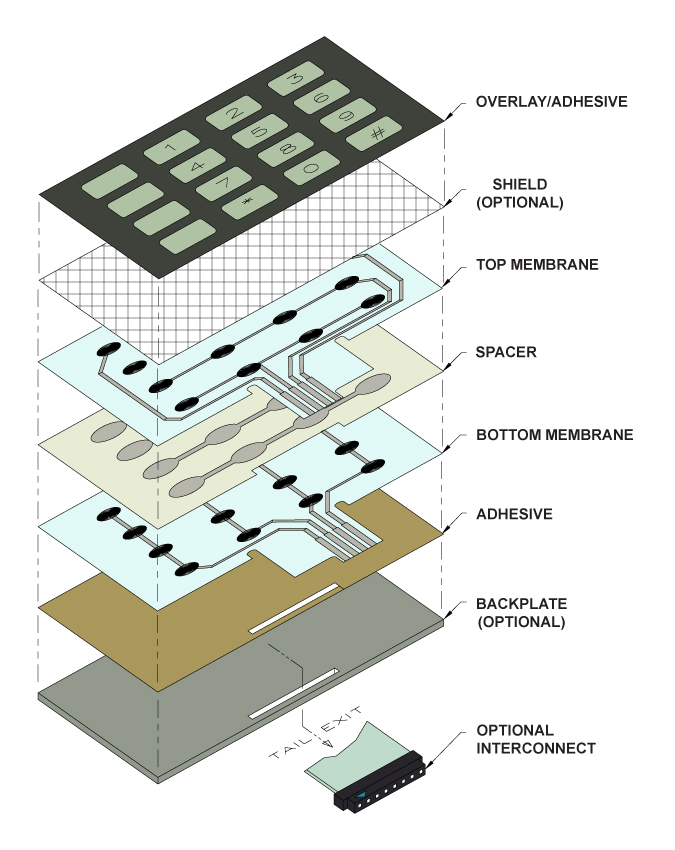Top Advantages of Integrating a Membrane Switch Into Your Electronic Equipment
Top Advantages of Integrating a Membrane Switch Into Your Electronic Equipment
Blog Article
Understanding the Functionality of Membrane Layer Switches Over for Interface Devices
The capability of membrane switches over represents a considerable advancement in individual interface design, integrating performance with aesthetic adaptability. As sectors progressively focus on customer experience, comprehending the subtleties of membrane layer button modern technology comes to be vital.
What Are Membrane Switches?
Membrane switches are ingenious user interface devices that promote individual interaction with electronic devices. These flexible parts contain multiple layers, including a graphic overlay, spacer, and a printed circuit layer. The design allows for a smooth integration into various electronic tools, boosting both the aesthetic and functional facets of interface.
Membrane layer buttons are generally employed in a large range of applications, from family appliances to commercial equipment and clinical gadgets. Their construction generally features a thin account, making them an excellent choice for portable styles. The responsive feedback provided by these buttons can be crafted to fulfill details individual choices, ensuring efficient communication between the user and the tool.
Durability is another substantial benefit of membrane buttons, as they are resistant to dirt, dampness, and chemicals, which boosts their lifespan in demanding settings. In addition, these buttons can be personalized in regards to shape, size, and graphic design, permitting branding and user-specific functions. Overall, membrane layer switches stand for a practical option for enhancing user experience in digital devices, incorporating performance with visual charm in an effective manner.
Exactly How Membrane Switches Job
Operating on a straightforward concept, membrane layer changes use a split building and construction to sign up user input successfully. Each switch is composed of numerous layers, including a published circuit layer, a spacer layer, and a top visuals layer, which are created to collaborate flawlessly. When a customer presses the top layer, it presses the spacer layer, bringing the conductive elements of the circuit layer right into contact with each various other.
This contact produces a shut circuit, signifying the device to implement a details feature. The design enables numerous configurations, consisting of tactile feedback, which can enhance the customer experience by providing a physical feeling upon activation. The materials utilized in membrane layer buttons commonly include versatile substratums, such as polyester or polycarbonate, which make sure durability and durability against wear and tear.

Trick Benefits of Membrane Switches

Another substantial advantage is their density. Membrane layer switches are slim and light-weight, which allows makers to save room in their gadgets without sacrificing performance. This feature is specifically beneficial in applications where weight and volume are essential factors to consider.
Furthermore, membrane buttons are resistant to dust, moisture, and chemicals, boosting their sturdiness. This resilience expands their lifespan and lowers the demand for regular substitutes, leading to price savings with time.
Furthermore, the responsive comments offered by membrane layer switches can be enhanced to boost user communication. They can include functions such as increased buttons or audible clicks, boosting usability and individual experience.
Applications Throughout Industries
User interface gadgets making use of membrane switches prevail in a wide variety of sectors, showcasing their adaptability and functionality. Membrane Switch. In the medical market, membrane layer switches are essential to tools such as analysis equipment and client monitoring systems, where their toughness and convenience of cleaning are important for preserving hygiene requirements. In the automotive market, these switches are utilized in control panel controls and infotainment systems, providing a sleek and modern interface for customers.
Additionally, the customer electronic devices market take advantage of membrane layer buttons in home appliances and handheld gadgets, where compact layout and easy to use user interfaces improve customer experience. Industrial applications likewise leverage membrane switches over for control panels in equipment and automation systems, stressing their robustness and resistance to severe settings.
In the aerospace and description defense industries, membrane switches are used in cabin controls and equipment, where integrity and efficiency under extreme problems are extremely important. In addition, the pc gaming sector significantly incorporates membrane buttons in controllers and gallery devices, contributing to an engaging customer experience. On the whole, the versatility of membrane switches over enables their widespread use throughout countless sectors, emphasizing their significance in modern user interface design.
Future Fads in Membrane Layer Switch Modern Technology

Additionally, using innovative products, such as polycarbonate and polyester films, is anticipated to climb, giving boosted resilience and resistance to environmental stressors. These products contribute to the general long life of membrane buttons, making them ideal for harsher industrial applications.
In addition, the incorporation of wise technology, including IoT connectivity, will enable membrane buttons to interact with various other tools and systems, promoting a much more interactive customer experience. This pattern aligns with the growing need for clever tools throughout various industries, from healthcare to consumer electronics.
Lastly, personalization choices are prepared for to increase, permitting producers to create bespoke remedies customized to specific customer requirements and preferences. These growths will certainly place membrane buttons as vital parts in the evolution of interface modern technology.
Conclusion
Finally, membrane layer switches stand for a critical improvement in interface technology, offering a reliable and versatile service for diverse electronic applications. Their split construction promotes small layout, while features such as responsive responses boost individual interaction. The sturdiness against ecological elements additionally strengthens their energy across several industries. As innovations in product scientific research and touch picking up modern technologies proceed, the capability and applicability of membrane switches are expected to increase, strengthening their importance in modern electronic tools.
Report this page